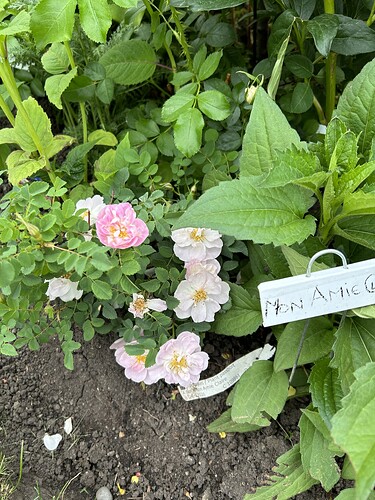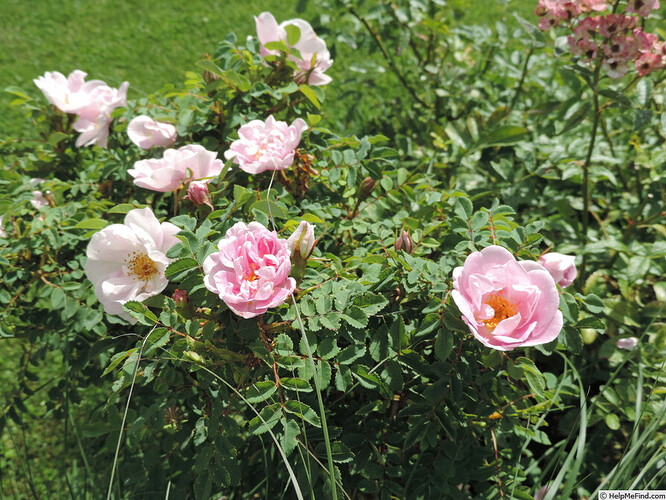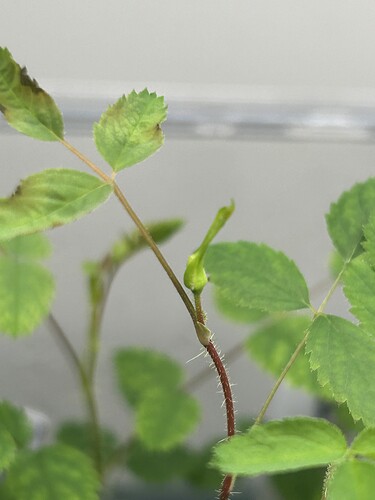The season for hybridizing has begun here, and I’m looking at crosses to make this year. While I’m willing to be patient waiting for the seedlings from my main project of rugosa crosses to bloom, I also enjoy having some fast-blooming seedlings on the side.
So my first question is, aside from HT’s and floribundas, what rose classes generally have juvenile bloom? Do OGR classes like Bourbons, Damasks, and HPs do it? What about other things like polyanthas, teas or hybrid musks? Do crosses with non-rugosa species roses (currently growing r. Glutinosa and r. Sancta) bloom the first year?
Another question is about the genetics of juvenile bloom. I thought it was true that whatever gene controls juvenile bloom is distinct from the gene for rebloom, since for example rugosas may have a very long juvenile period but then repeat. However I then found a 1975 article on Karl K’s website that says that actually, there isn’t a gene that controls juvi bloom:
“As to roses, it is concluded that the juvenile period is the result of the genetically controlled development of the seedling rather than an independent entity governing these processes.”
Source
Is this view still the current one? Is juvi bloom not a separate gene? If so, does this mean juvi bloom cannot be passed on? As a hobbyist, I find this topic very confusing.
Any insight would be appreciated!
There is a lot of info already on the forum regarding the genetics of reblooming:
Types of Repeat Flowering in Roses
Alternate source for repeat bloom
Rose Continuous Flowering Regulator
-Jonathan
Thank so much for replying @Jwindha !
However I’m confused by your reply, since my questions are about juvenile bloom, not repeat bloom. But maybe the error is in my question itself.
Are you saying that, except for rugosas, all the rose classes that repeat bloom are also juvenile bloomers?
If that’s the case sorry for my ignorance. I have only so far experimented with moderns and rugosa hybrids!
Hello SeasideRooftop! Below you will find an informative study on your question.
Maybe it can give you some more insights. Enjoy the reading.
http://www.globalsciencebooks.info/Online/GSBOnline/images/0906/FOB_3(SI1)/FOB_3(SI1)46-52o.pdf
Thank you very much Roseus!
That article is very, very interesting, it’s going to take me a few read-throughs to fully understand everything, but this is indeed extremely helpful. At least now I think I understand why Jwindha replied with the threads about rebloom.
It’s important not to regard all rose classes as monolithic from a remontancy standpoint; in particular, a number of the historically intermediate classes are actually quite heterogeneous in terms of their rebloom and its genetic control. Some Bourbon roses are fairly quick to rebloom, and their seedlings will tend to have juvenile bloom and fast repeat when they crossed with other roses having a similar flowering frequency potential. That fast repeat is probably driven mostly by the RoKSN copia allele, with reduced or maybe even no influence from the RoKSN A181 allele that would have been passed on by ‘Autumn Damask’. However, other roses technically classified as Bourbons only occasionally repeat bloom or will even tend to flower only once per year, and those will produced much more mixed percentages of rebloom and juvenile bloom when crossed with roses having faster repeat flowering. The same is true of hybrid perpetuals–it’s quite a mixed class that is all over the map in terms of repeat bloom, and it probably follows that these variously derive their flowering from the RoKSN copia allele, the A181 allele, or some combination of the two, possibly with other modifying factors that are less clearly understood.
Some other classes that have RoKSN copia-type everblooming behavior (in addition to stereotypical modern roses like hybrid teas and floribundas) include Chinas, teas, Noisettes, polyanthas, and hybrid musks, plus many everblooming “shrub” roses. These will all generally produce juvenile-flowering seedlings that can rebloom fairly quickly when they are crossed with others having the same kind of remontancy.
Beyond that, it can get complicated. Some roses repeat in certain climates or weather conditions but not others; even the fastest repeat bloomers will become slow (with tiny flowers) or even stop flowering under sustained high temperatures. Some breeding results can be unexpected and expose how little we know. Some non-remontant roses with no known genetic mechanism for remontancy can apparently produce juvenile-flowering, remontant seedlings when crossed with roses that are homogeneous for the RoKSN copia allele. For instance, ‘Harison’s Yellow’ has produced juvenile-flowering, fully remontant seedlings for me when crossed with ‘Louise Odier’ and with ‘Auscot’ (Abraham Darby). The influence of ‘Harison’s Yellow’ in the offspring was very clear, although they were disappointingly no more cold-hardy than their more tender parents in a fairly cold winter climate. Occasional remontancy that’s probably based on the A181 allele–possibly without any juvenile bloom, although that was probably not recorded–has followed by similar means from crosses of R. foetida ‘Persiana’ (with the HP ‘Ardoisee de Lyon’, producing ‘Soleil d’Or’, R. rugosa, producing ‘Agnes’). More frequent remontancy, also from the RoKSN A181 allele, followed from the probable cross between R. spinosissima and ‘Autumn Damask’, producing ‘Stanwell Perpetual’; a backcross of ‘Stanwell Perpetual’ to R. spinosissima further produced the repeat-blooming ‘Paula Vapelle’ and ‘Mon Ami Claire’. We don’t even know the basis for remontancy in some other roses, like R. roxburghii f. roxburghii, although it seems like a RoKSN A181 type to me, but the species otherwise flowers only once per season. The same could probably be said for R. bracteata; its crossing with a tea rose produced ‘Mermaid’, which repeats almost as frequently as it draws blood from passers-by.
Stefan
Thank you so much for taking the time to explain this in detail!
I now understand how inadequate the framing of my original question was. In addition I shouldn’t have considered the classes as homogeneous blocks. It definitely seems like the topic can get much more complex than I thought, but it’s great to have at least a broad idea of what to expect from certain classes. I’ll do more reading, and I’ll keep your examples in mind for in my pollinations this spring. Thanks again!
Good to know where a favourite Mon Amie Claire came from.
A tiny star so far in my garden that never really stops blooming, Vapelle a close second - larger blooms - both bone hardy - first kneel down to look at roses l like.
I just got Mon Amie Claire and Paula Vapelle, verge excited!
Mon Ami Clarke bloom (opened in morning) last June. Turns quickly white. First time l caught the “pink” and it was impressive to me.
That shading is lovely! If I had that one, I’d probably try crossing it with ‘Suzanne’. Juvenile bloom may or may not happen with only the A181 allele involved, but repeat flowering seems likely.
There has been a question raised that this vendor tagged Louette rose “Mon Amie Claire”(MAC), maybe Knud’s “Blushing Love” (BL)… have vendor tagged BL also from Europe - no pink has shown, plus Knud’s Peter Boyd and a Paula Val. (all same vendor … Knud).
Mixed tags can cause problems that are rarely cleared with certainty … though blush should be a dead give away. Though was pleased to hear “lsabelle Skinner” got her name back from a foreign country after her home country forgot she still existed.
… if mine a sport l claim ownership …. yuk, yuk.
So now other question is the labelled BL the real MAC (2005) of the Belgium hybridizer lvan Louette, who apparently named after his Montreal Botanical Garden friend in Quebec CDN.
Pics of same “?mislabelled MAC rose?” in same summer. l’ld like to vote “sport” as a terrific rose, and all due to my TLC … yukyuk.
But I can’t in all good conscience … reasons are visual, some written, as follows in pics and HMF note below …. its labelled correctly IMO as the rose in place known as Mon Amie Claire by Louette.
Mine is three years old. It fills all these HMF attributes, plus is labelled as such … “Seashell-pink, ages to white . Strong fragrance. Small, semi-double (9-16 petals), in small clusters bloom form. Blooms in flushes throughout the season”.
I add hardy to hardcore in my garden.
Go in peace Riku, the vendor labelled it right, so you have the right rose in your garden. And what a prize, I am still tempted to ordered a half dozen for a front border its that good, in my zone 4A CDN garden, with no black spot worth mentioning.
MAC photo on HMF … it looks pretty blush to me.
Any non monetary wager on whether a very early juvenile - l don’t know. Fanny Heath, Dr Skinner effort ~ 1940s.
The germinated seedling not out of diapers ~ 3 months old and still kept indoors - humidity. Very susceptible to fungal attack as a seedling in my damp chambers.
From Helpmefind
“Bred by [Dr. Frank Leith (Canada, before 1942).
Shrub, Species Cross.
Pink. Double (17-25 petals) bloom form.
USDA zone 2b
R. rugosa × R. acicularis
Deep rose flowers of H.P. form and very fragrant. Hardy with light protection. [Dropmore catalogue 1942”
My seedling
”June 9th
A million IF’s to come concerning this rose’s juvee “color”.
Been living in pearlite since sent to stratication, but today outside in real soil and real all day sun.
But realistically it’s not showing early vigour … nor should it be that color. Also location makes me think hallmark of blind shoot. Maybe to right is a new shoot or bud developing.
Anyways real curiosity to moi to follow.





